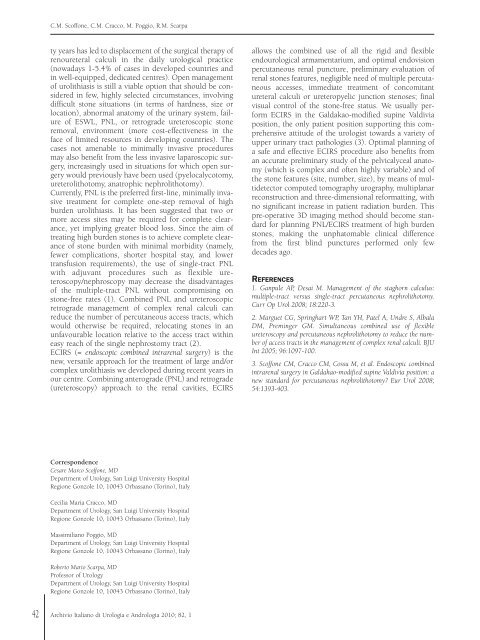Summary - Salute per tutti
Summary - Salute per tutti
Summary - Salute per tutti
- No tags were found...
You also want an ePaper? Increase the reach of your titles
YUMPU automatically turns print PDFs into web optimized ePapers that Google loves.
C.M. Scoffone, C.M. Cracco, M. Poggio, R.M. Scarpaty years has led to displacement of the surgical therapy ofrenoureteral calculi in the daily urological practice(nowadays 1-5.4% of cases in developed countries andin well-equipped, dedicated centres). Open managementof urolithiasis is still a viable option that should be consideredin few, highly selected circumstances, involvingdifficult stone situations (in terms of hardness, size orlocation), abnormal anatomy of the urinary system, failureof ESWL, PNL, or retrograde ureteroscopic stoneremoval, environment (more cost-effectiveness in theface of limited resources in developing countries). Thecases not amenable to minimally invasive proceduresmay also benefit from the less invasive laparoscopic surgery,increasingly used in situations for which open surgerywould previously have been used (pyelocalycotomy,ureterolithotomy, anatrophic nephrolithotomy).Currently, PNL is the preferred first-line, minimally invasivetreatment for complete one-step removal of highburden urolithiasis. It has been suggested that two ormore access sites may be required for complete clearance,yet implying greater blood loss. Since the aim oftreating high burden stones is to achieve complete clearanceof stone burden with minimal morbidity (namely,fewer complications, shorter hospital stay, and lowertransfusion requirements), the use of single-tract PNLwith adjuvant procedures such as flexible ure -teroscopy/nephroscopy may decrease the disadvantagesof the multiple-tract PNL without compromising onstone-free rates (1). Combined PNL and ureteroscopicretrograde management of complex renal calculi canreduce the number of <strong>per</strong>cutaneous access tracts, whichwould otherwise be required, relocating stones in anunfavourable location relative to the access tract withineasy reach of the single nephrostomy tract (2).ECIRS (= endoscopic combined intrarenal surgery) is thenew, versatile approach for the treatment of large and/orcomplex urolithiasis we developed during recent years inour centre. Combining anterograde (PNL) and retrograde(ureteroscopy) approach to the renal cavities, ECIRSallows the combined use of all the rigid and flexibleendourological armamentarium, and optimal endovision<strong>per</strong>cutaneous renal puncture, preliminary evaluation ofrenal stones features, negligible need of multiple <strong>per</strong>cutaneousaccesses, immediate treatment of concomitantureteral calculi or ureteropyelic junction stenoses; finalvisual control of the stone-free status. We usually <strong>per</strong>formECIRS in the Galdakao-modified supine Valdiviaposition, the only patient position supporting this comprehensiveattitude of the urologist towards a variety ofup<strong>per</strong> urinary tract pathologies (3). Optimal planning ofa safe and effective ECIRS procedure also benefits froman accurate preliminary study of the pelvicalyceal anatomy(which is complex and often highly variable) and ofthe stone features (site, number, size), by means of multidetectorcomputed tomography urography, multiplanarreconstruction and three-dimensional reformatting, withno significant increase in patient radiation burden. Thispre-o<strong>per</strong>ative 3D imaging method should become standardfor planning PNL/ECIRS treatment of high burdenstones, making the unphatomable clinical differencefrom the first blind punctures <strong>per</strong>formed only fewdecades ago.REFERENCES1. Ganpule AP, Desai M. Management of the staghorn calculus:multiple-tract versus single-tract <strong>per</strong>cutaneous nephrolithotomy.Curr Op Urol 2008; 18:220-3.2. Marguet CG, Springhart WP, Tan YH, Patel A, Undre S, AlbalaDM, Preminger GM. Simultaneous combined use of flexibleureteroscopy and <strong>per</strong>cutaneous nephrolithotomy to reduce the numberof access tracts in the management of complex renal calculi. BJUInt 2005; 96:1097-100.3. Scoffone CM, Cracco CM, Cossu M, et al. Endoscopic combinedintrarenal surgery in Galdakao-modified supine Valdivia position: anew standard for <strong>per</strong>cutaneous nephrolithotomy? Eur Urol 2008;54:1393-403.CorrespondenceCesare Marco Scoffone, MDDepartment of Urology, San Luigi University HospitalRegione Gonzole 10, 10043 Orbassano (Torino), ItalyCecilia Maria Cracco, MDDepartment of Urology, San Luigi University HospitalRegione Gonzole 10, 10043 Orbassano (Torino), ItalyMassimiliano Poggio, MDDepartment of Urology, San Luigi University HospitalRegione Gonzole 10, 10043 Orbassano (Torino), ItalyRoberto Mario Scarpa, MDProfessor of UrologyDepartment of Urology, San Luigi University HospitalRegione Gonzole 10, 10043 Orbassano (Torino), Italy42Archivio Italiano di Urologia e Andrologia 2010; 82, 1
















